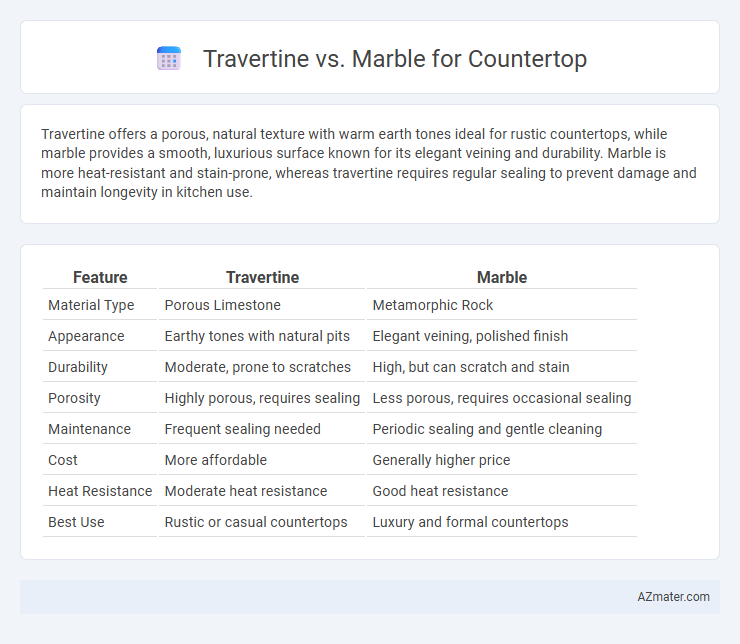Travertine offers a porous, natural texture with warm earth tones ideal for rustic countertops, while marble provides a smooth, luxurious surface known for its elegant veining and durability. Marble is more heat-resistant and stain-prone, whereas travertine requires regular sealing to prevent damage and maintain longevity in kitchen use.
Table of Comparison
| Feature | Travertine | Marble |
|---|---|---|
| Material Type | Porous Limestone | Metamorphic Rock |
| Appearance | Earthy tones with natural pits | Elegant veining, polished finish |
| Durability | Moderate, prone to scratches | High, but can scratch and stain |
| Porosity | Highly porous, requires sealing | Less porous, requires occasional sealing |
| Maintenance | Frequent sealing needed | Periodic sealing and gentle cleaning |
| Cost | More affordable | Generally higher price |
| Heat Resistance | Moderate heat resistance | Good heat resistance |
| Best Use | Rustic or casual countertops | Luxury and formal countertops |
Introduction to Travertine and Marble Countertops
Travertine and marble are both popular natural stone choices for countertops, renowned for their unique textures and elegant appearances. Travertine features a porous surface with a matte finish and warm, earthy tones, while marble is characterized by its smooth, polished surface and distinctive veining patterns. Both materials offer durability and timeless beauty but require proper sealing and maintenance to prevent staining and damage in kitchen environments.
Key Differences Between Travertine and Marble
Travertine countertops feature a porous surface with distinct natural pits, offering a more rustic and textured appearance compared to the smooth, polished finish of marble. Marble countertops are composed primarily of calcite, resulting in a denser, harder surface that is more resistant to scratches but prone to acid etching, unlike the softer, more absorbent travertine. The color palette of travertine often includes warm beige, tan, and cream tones, whereas marble showcases a broader range with dramatic veining patterns in white, black, and green hues.
Appearance and Aesthetic Appeal
Travertine offers a naturally porous surface with warm, earthy tones and distinctive hole patterns, creating a rustic and inviting countertop appearance. Marble provides a smooth, polished finish with elegant veining and a wider range of color options, delivering a luxurious and timeless aesthetic. Both stones enhance kitchen design, but marble's high gloss and refined patterns generally appeal more to those seeking sophistication and classic beauty.
Durability and Longevity
Travertine countertops offer moderate durability with natural porousness requiring regular sealing to prevent stains and erosion, making them less long-lasting than marble in high-traffic kitchens. Marble countertops boast superior hardness and resistance to heat and scratches, enhancing their longevity and maintaining aesthetic appeal over decades with proper care. Choosing marble ensures a more durable, long-lasting countertop surface, while travertine suits lower-usage areas with maintenance commitment.
Maintenance and Cleaning Requirements
Travertine countertops demand regular sealing every 1-2 years to prevent staining due to their porous nature, while marble also requires sealing but is slightly less porous and more resistant to acids. Cleaning travertine should involve pH-neutral cleaners to avoid etching, whereas marble needs gentle, non-abrasive products to maintain its polished surface. Both materials are sensitive to acidic substances, but travertine's open texture makes it more prone to harboring dirt, necessitating more frequent upkeep.
Cost Comparison: Travertine vs Marble
Travertine countertops generally cost between $10 to $30 per square foot, making them a more budget-friendly option compared to marble, which ranges from $40 to $100 per square foot. The price difference is influenced by the availability, quarrying process, and the unique veining of marble versus the porous, textured surface of travertine. Maintenance costs also vary, as marble requires more frequent sealing and can be more susceptible to scratches and stains, potentially increasing overall long-term expenses.
Stain and Scratch Resistance
Travertine countertops are more porous and prone to staining compared to marble, requiring regular sealing to maintain their appearance. Marble offers better scratch resistance due to its denser structure but can still be vulnerable to acidic stains and etching. Both materials demand careful maintenance, but marble generally provides superior durability for stain and scratch resistance in kitchen applications.
Installation Process and Considerations
Travertine countertops require careful sealing before and after installation to prevent staining due to their porous nature, whereas marble demands precise cutting and skilled handling to avoid chipping because of its softer composition. Both stones need a stable, level substrate to ensure proper adhesion and longevity, but travertine's uneven surface texture can complicate installation compared to the smoother finish of marble. Consideration of weight, moisture sensitivity, and maintenance requirements is crucial during the installation process for both materials to optimize durability and appearance.
Environmental Impact and Sustainability
Travertine countertops have a lower environmental impact than marble due to their abundant availability and less intensive quarrying processes, making them a more sustainable choice for eco-conscious homeowners. Marble extraction involves higher energy consumption and contributes to greater carbon emissions, while travertine's natural porous structure reduces the need for additional chemical treatments. Choosing travertine promotes sustainability by minimizing resource depletion and lowering the overall carbon footprint associated with countertop materials.
Choosing the Best Stone for Your Countertop Needs
Travertine offers a porous, textured surface that lends a warm, natural aesthetic, while marble provides a smooth, elegant appearance with unique veining patterns. Travertine's durability suits low-traffic kitchens but requires sealing to prevent stains, whereas marble is more heat resistant yet prone to scratching and etching from acidic substances. Selecting the best stone depends on your countertop's exposure to wear, maintenance commitment, and desired visual impact.

Infographic: Travertine vs Marble for Countertop
 azmater.com
azmater.com